Single-leg stability training improves your balance and prevents injuries. Focus on proper posture throughout each exercise, maintaining slow controlled movements. Start with basic exercises before progressing to advanced variations. Always warm up and stretch after workouts. Gradually increase difficulty by adding weights or using unstable surfaces like mini-trampolines. Engage your core for maximum stability during every exercise. Learn how these fundamental principles can transform your stability training and boost athletic performance.
5 Single-Leg Stability Training Tips
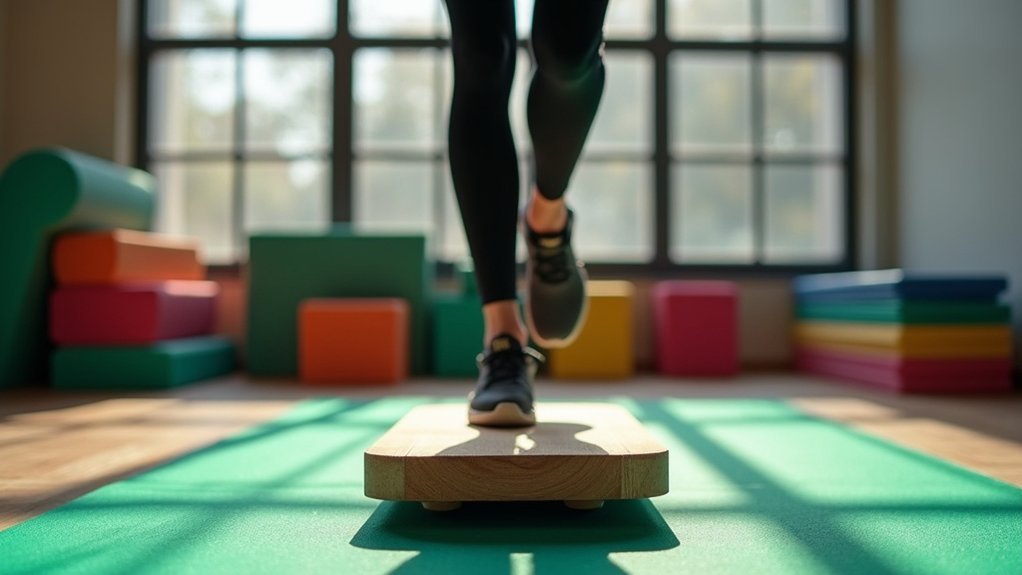
Whether you’re an athlete seeking to enhance performance or someone looking to build functional strength, single-leg stability training offers tremendous benefits for your fitness journey.
Focus on maintaining proper posture during exercises like Single-Leg Step-Ups and RDLs to maximize effectiveness and prevent injury.
Keep movements slow and controlled to enhance muscle engagement, but incorporate explosive power where appropriate.
Prioritize balance throughout each exercise, starting with basic movements before progressing to more challenging variations.
Don’t skip warm-ups or post-workout stretching, as they’re essential for injury prevention.
As you improve, gradually increase difficulty through progressive overload – add weights, adjust height, or introduce unstable surfaces like BOSU balls.
Watch your foot positioning carefully, as incorrect placement can compromise both your balance and targeted muscle activation.
Incorporating exercises like lunges, single leg deadlifts, and the Goblet Landmine Skater Squat will help address muscle imbalances that often go unnoticed in bilateral movements.
Master the Fundamentals of Rebounding Balance
As you step onto a rebounder for the first time, you’ll quickly discover that mastering balance requires more than just bouncing up and down. Start by engaging your core muscles—they’re your stability powerhouse.
Maintain proper posture with shoulders back and knees slightly bent to prevent injuries.
Begin with basic jumps to build your foundation before progressing to weight-shifting techniques. Even if you’re a seasoned triathlete, start as beginner to develop proper technique. Practice transferring weight from side to side to challenge your stabilizer muscles and enhance coordination. Each landing simulates a controlled fall, training your body’s balance reflexes.
Start simple, then challenge your balance. Every bounce trains your body to stay centered through controlled instability.
Remember that rebounding is wonderfully low-impact, making it ideal for all fitness levels. Focus on controlled movements rather than height, and you’ll strengthen not just your balance but also your bones and muscles throughout your body.
Progressive Overload for Single-Leg Rebounding
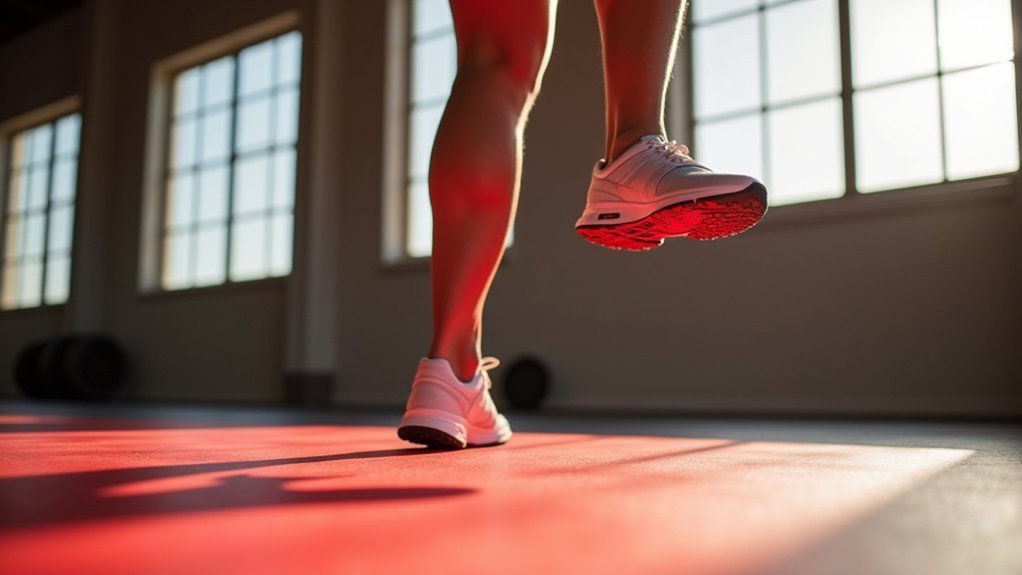
Progressive overload lies at the heart of any effective single-leg rebounding routine, challenging your body to continually adapt and grow stronger.
To implement this principle, gradually increase your workout intensity through various strategies. Start by expanding your movement range during exercises, then systematically add more repetitions as your endurance improves. The Jump Instead program shows that this approach activates muscles more effectively over time, leading to better strength development.
When you’ve mastered basic movements, incorporate resistance bands or small weights to increase difficulty.
Mix up your routine with different rebounding exercises to target various muscle groups. Always prioritize proper form over intensity to prevent injuries.
Remember to warm up thoroughly before each session and verify your equipment is in good condition.
Set specific goals, maintain a consistent training schedule, and don’t underestimate the importance of rest days for muscle recovery and adaptation.
Core Engagement Techniques During Instability Training
Core engagement forms the foundation of effective single-leg stability training, transforming wobbly attempts into powerful, controlled movements.
The synergy between core strength and single-leg balance transforms instability into purposeful, stable movement patterns.
When balancing on one leg during instability work, your core serves as the command center for maintaining proper alignment and preventing compensatory patterns.
- Brace, don’t hollow – Create 360-degree tension through your midsection by expanding your abdominal wall outward rather than drawing in, particularly during rotational challenges.
- Incorporate anti-rotation work – Use Pallof presses and offset loading to force your obliques to resist rotational forces.
- Fix your gaze – Maintain visual focus on a stable object to enhance neuromuscular coordination.
- Synchronize breathing – Exhale during exertion phases while maintaining intra-abdominal pressure for peak stability. Proper single-leg exercises promote lumbo-pelvic stability and minimize unwanted movement between the rib cage and pelvis.
Proprioception Enhancement Through Mini-Trampoline Work
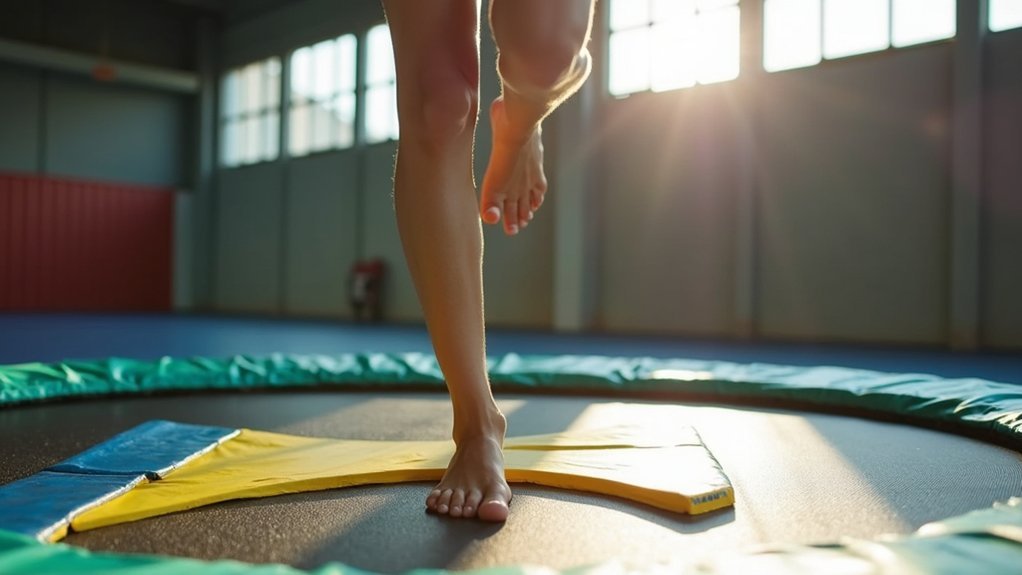
Mini-trampoline training offers three distinct advantages for developing proprioception—that essential sixth sense that helps you understand where your body is in space.
The dynamic surface creates constant balance challenges, forcing your muscles and joints to continuously adjust and send feedback to your brain.
Try single-leg exercises on your mini-trampoline to maximize proprioceptive development.
Begin with basic standing, then progress to gentle bouncing, and eventually incorporate movement variations like lateral hops.
You’ll notice your stability improving as your body’s position sensors become more refined.
For best results, use quality equipment like Bellicon trampolines that provide appropriate resistance and support.
This training is particularly valuable for seniors preventing falls, athletes enhancing performance, and rehabilitation patients rebuilding motor skills—all while enjoying low-impact cardiovascular benefits.
The combination of proprioceptive engagement and vestibular stimulation during mini-trampoline exercises creates an ideal environment for enhanced sensory integration.
Frequently Asked Questions
Can Single-Leg Training Help With Specific Sports Like Tennis or Basketball?
Yes, you’ll gain sport-specific benefits in tennis through improved rotational stability for serves, and in basketball by enhancing lateral stability for direction changes and vertical power for single-leg takeoffs during rebounds.
How Often Should I Incorporate Single-Leg Exercises Into My Weekly Routine?
You should incorporate single-leg exercises 2-3 times weekly if you’re a beginner, or 3-4 times weekly if you’re more advanced. Limit yourself to 2-3 single-leg movements per session to prevent overuse.
Is Single-Leg Training Beneficial During Rehabilitation From Knee Injuries?
Yes, you’ll greatly benefit from single-leg training during knee rehabilitation. It improves joint stability, enhances proprioception, prevents muscle imbalances, and reduces reinjury risk by strengthening neural pathways and promoting functional movement patterns.
At What Age Should Children Start Practicing Single-Leg Balance Training?
You can start introducing your child to single-leg balance training around 2½ years old. They’ll typically balance for about 4 seconds then, progressing to 5 seconds by age 3-4 with regular practice.
Can Single-Leg Exercises Help With Chronic Lower Back Pain?
Yes, single-leg exercises can help your chronic lower back pain by improving postural control, enhancing stability, and strengthening core muscles. They’re especially effective when incorporated into an extensive treatment plan targeting motor control and balance.
In Summary
You’ve now learned how to transform your stability using single-leg trampoline training. Start with the basics, gradually increase difficulty, engage your core, and focus on proprioceptive awareness. Don’t rush the process—consistent practice will strengthen those stabilizing muscles and improve your balance. Remember, these techniques aren’t just exercises; they’re rebuilding your body’s foundation for better performance in everything you do.


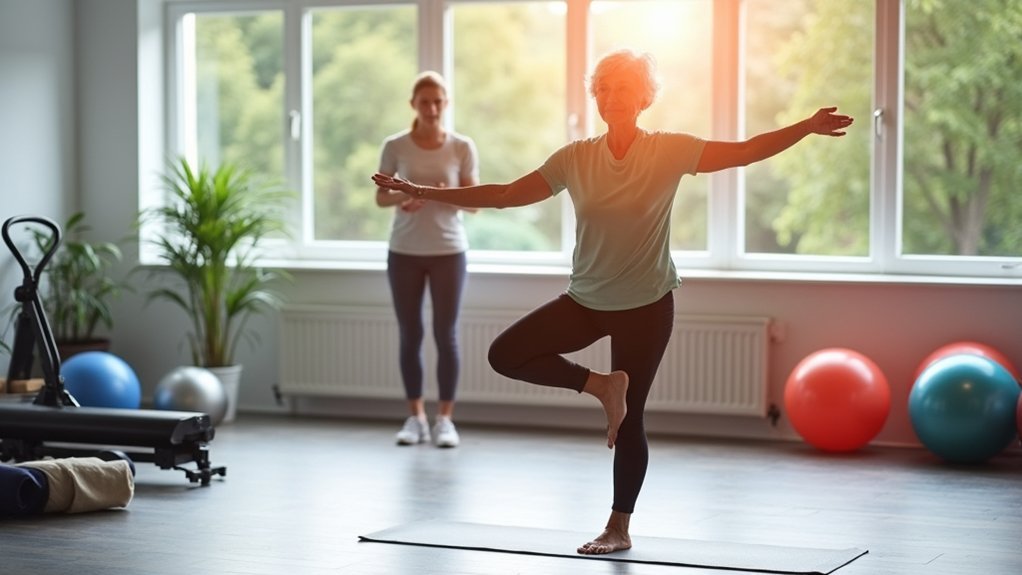
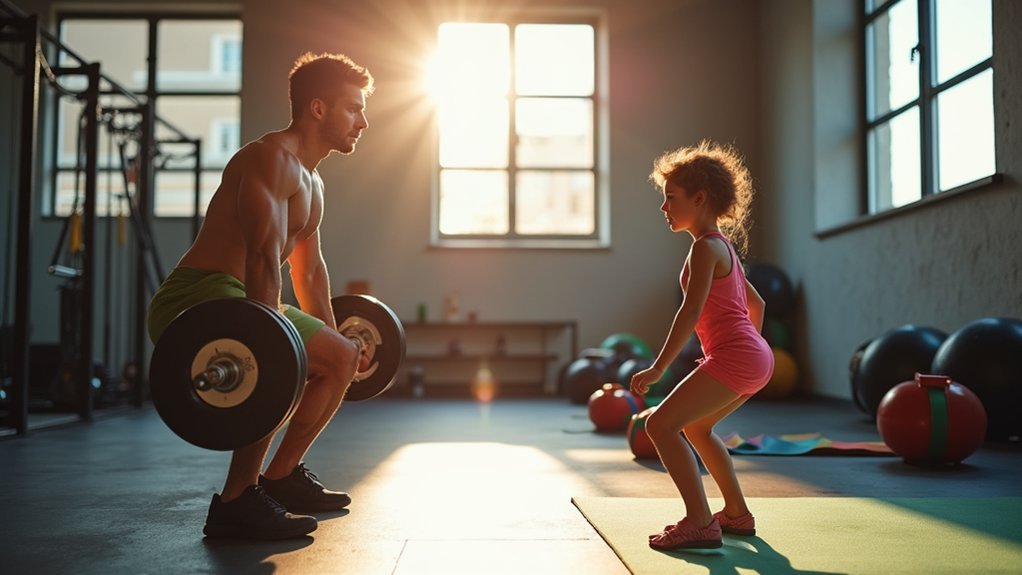

Leave a Reply